
As you read these words the special catalog for the Joel R. Anderson Collection has been completed by me, Peter Treglia, and other staff members. It has been a unique treat for all of us—the paper money equivalent of the D. Brent Pogue, Louis E. Eliasberg, Sr., and other incredible coin collections.
Starting years ago Joel determined to acquire one of each major design type, Treasury Seal change, and other significant transitions in the large-size federal money series from the first Interest-Bearing notes of 1861, seguing into the Demand Notes of the same year, and down through the decades to the final large-size issues of the 1920s. By definition he sought common notes as well as rarities, but all in the very highest grade possible. Some years ago he set the paper money collecting world abuzz by buying the first note ever to cross the auction block for more than a million dollars—a fabulous $1000 "Grand Watermelon" note (worthy of special mention in this week’s blog in view of the related $10 showcased).
The Anderson Collection Part I catalog will be one of five we are creating for the Whitman Coin & Collectibles Expo in Baltimore next month. This is always one of the top five shows of the year and, as the numismatic market is very strong, special enthusiasm is building toward this event.
Now to this week’s $10 Coin or Treasury Note, the finest of the fine. Here is the history of this series followed by our description of the note:
Treasury or Coin Notes, Series of 1890
The $10 Treasury or Coin Note displays an incredibly ornate back as seen on lower denominations of this series, and higher denominations as well. As such, these have been the object of intense interest from the numismatic community for a long time. The Joel R. Anderson Collection offers a definitive group of these, culminating with the aforementioned $1000 "Grand Watermelon" note to be offered in a future sale. The ornate backs of the different notes in this series have no equal among large-size federal issues.
The raison d’etre for this class of notes, was the "Silver Question," also known as the "Free Silver" movement. Western mining and other interests wanted Uncle Sam to support the sagging market for the metal by buying two to four million ounces of silver each month. This had been done since 1878, but for a short time up to this point, it seemed that Morgan silver dollars would no longer be made, as the supply, as authorized by the Bland-Allison Act of February 28, 1878, had run out. Congress stepped in with the Sherman Silver Purchase Act of 1890, which eventually continued the production of millions of silver dollars that were unwanted by the public and ended up in bulk storage (how we love those Morgan dollars today!).
Payments to suppliers were to be made by these Treasury Notes, also called Coin Notes. The production of Silver Certificates was halted, and these bills took their place for a time.
As only "coin" was specified, it was left to the discretion of the Secretary of the Treasury whether gold or silver should be exchanged for them. In practice, most people wanted gold, causing some anxiety among Treasury officials, who nonetheless paid out double eagles and other coins as requested.
Soon, silver dollars were again plentiful in current production. A new "gold rush" was ignited in Cripple Creek, Colorado, in 1891, and later in the decade the Klondike furnished additional supplies. This resulted in increased coinage of gold, but still the export demand was so great that supplies held by the Treasury were often dangerously low, especially in the several years before "Silverite" William Jennings Bryan lost the 1896 election. After that time, Treasury reserves increased dramatically.
Returning to the Anderson note:
The face of the $10 features the portrait of General Philip Henry Sheridan, one of many Union heroes depicted on late 19th century federal notes. The portrait was engraved by Lorenzo Hatch, a Bureau of Engraving and Printing specialist in this field. The Series of 1890 Notes all have serial numbers beginning with A and ending with a decorative star. The back is filled with rich green engraving, edge to edge, with a large "TEN" at the center, ornamented with leaves within each letter.
The presently-offered variety with the Rosecrans-Nebeker signature combination, with large brown Treasury Seal, was made in smaller quantities and today is a prime rarity. However, a hoard of over two dozen Uncirculated notes, consecutively numbered, has augmented the supply. The Anderson note is the finest certified. We estimate the print run as 1,460,000 with fewer than 175 existing today, mostly in circulated grades.
Superb Gem New 68 PPQ "Ornate Back" $10 Treasury Note
Single Finest Graded Example
Fr. 368 (W-1522). 1890 $10 Treasury Note. PCGS Superb Gem New 68 PPQ. This "Ornate Back" 1890 $10 Treasury Note is the single finest graded $10 Treasury Note for all types combined. This is a very special showpiece as the Treasury Notes series stands high in popularity and beauty.
The centering on this Superb Gem is nearly perfect and there are razor sharp corners. The creamy white paper is completely original and the surfaces are free of any detracting marks. Bold red overprint inks are found on the face. The 1890 Treasury Notes are known for their beautifully ornate back designs and on this note the back is exceptionally well printed, with sharply printed green inks across all but the wide margins. This is an incredible opportunity to secure the finest representative of a very popular type.
PCGS Population 1; none finer.
From Currency Auctions of America’s sale of January 1998, lot 1673; Lyn Knight’s sale of June 2000; Jay Parrino’s February 2002 Fixed Priced list; Heritage Auctions’ sale of September 2005, lot 17388; Lyn Knight’s sale of June 2007, lot 71.





